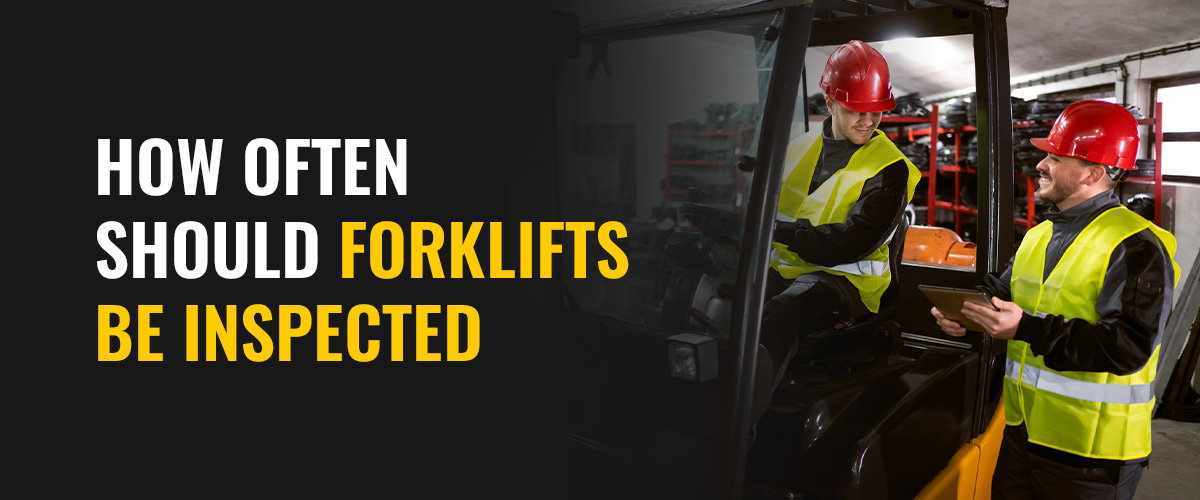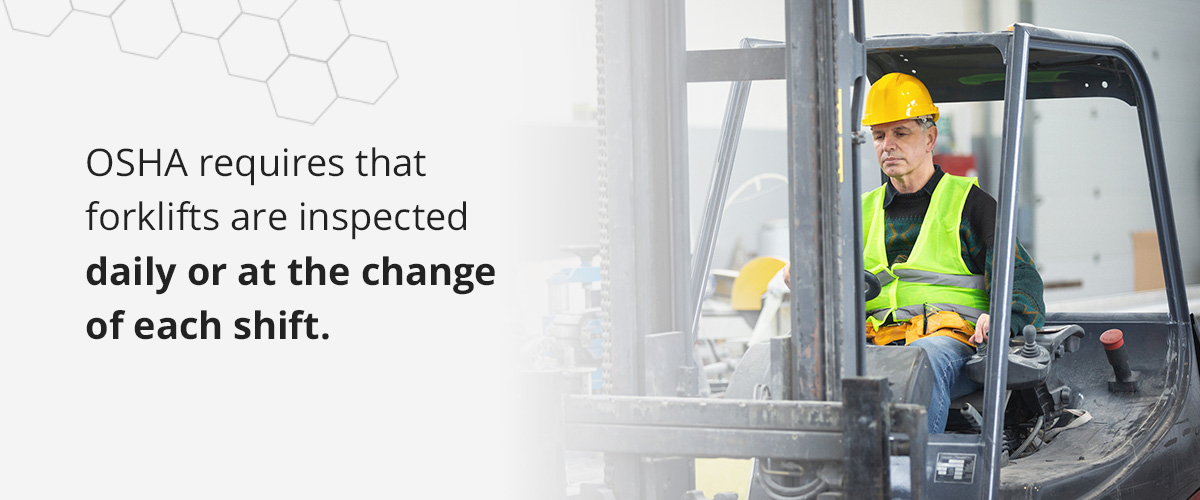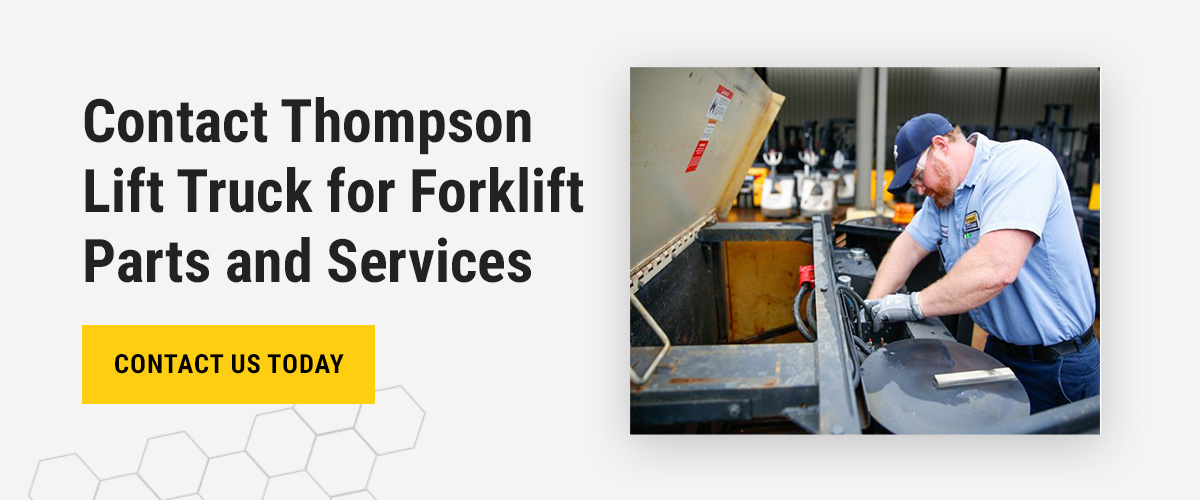
How Often Should Forklifts Be Inspected?
Forklift operation requires focus and professionalism to operate correctly and safely in the workplace. Forklifts are used in many industries, including manufacturing plants, warehousing, and retail. While forklifts are essential to many businesses, some operations overlook the need for inspections, affecting overall safety and efficiency.
A forklift that’s not inspected correctly could break down or go out of control if a significant problem goes unnoticed. Complacency in forklift inspections can have costly consequences, including asset damage, injury, fines, and even death. In many cases, forklift accidents are avoidable with the proper maintenance, inspections, and care. Forklift inspections can be the difference between peak operational efficiency and costly downtime, throwing your entire operation off schedule.
How Often Should Operators Inspect Their Forklift?
Operators should inspect their forklifts at least once daily. Inspections help keep your work environment safe and reduce the risk of needing costly repairs. A malfunctioning forklift can risk the lives of operators and surrounding workers, especially if it loses control due to faulty steering, worn-out brakes, or old seatbelts. Inspections help operators identify if the forklift is safe to operate.
Daily forklift inspections are required, and performing inspections has many benefits, including:
- Extend equipment life: Daily inspections help catch problems before they become a significant issue that can cause damage to other components of the forklift. You can stay on top of maintenance tasks that will help keep your forklift in good condition, extending its useful life.
- Minimize costs: Taking care of minor problems before they become severe can help you reduce overall care costs since you won’t have to worry about making significant and expensive repairs.
- Improve uptime: Inspections help reduce the risk of an unexpected breakdown resulting in lost time in the workplace. While inspections can take a few minutes out of the day, that’s significantly less than breakdowns or malfunctions that cause processes to come to a full stop. Instead, inspections will help improve uptime and keep your projects on schedule.
Daily inspections aren’t just recommended — they are required by the Occupational Safety and Health Administration. OSHA also requires inspections at the change of each shift, meaning any time the forklift changes operators, usually in facilities that are open 24 hours a day.
Forklift Inspection Requirements
OSHA has strict requirements stating that forklifts must be inspected at least once daily and before starting a new shift if the forklift is in a continuous-use facility. Regular preventative maintenance is also required to keep equipment safe and in the best condition possible.
The three primary OSHA guidelines for forklift maintenance include:
- Never operate a forklift knowing it is unsafe or hasn’t undergone a recent inspection.
- Remove active forklifts from use for repairs, which should only be performed by trained personnel.
- Maintain forklifts to keep a clean appearance and condition, free from noticeable dirt, dust, grease, oil, and other substances.
Even if you’re not using your forklift daily, it should be inspected a minimum of three or four days each week. Trained personnel should perform the inspections to ensure they are completed accurately and thoroughly. Forklift inspections should include inspecting various components, including tires, brakes, forks, lights, and other essential parts. A general rule of thumb is to check any component that moves or impacts safety.
Operators should conduct a visual pre-check and an operational pre-check to determine the operational efficiency of different safety systems, such as signals, brakes, harnesses, and cockpit controls. If your operators notice any defects or abnormalities, they should report them immediately so the problem can be managed promptly. Forklift operators and maintenance personnel should be in constant contact to ensure the safety and health of the machinery.
You can also offer incentives for regular maintenance activities so workers feel more motivated to keep up with daily required maintenance tasks, such as gift cards or extra vacation time for a certain number of days where maintenance wasn’t skipped. You should also post your maintenance and inspection requirements for all employees to see. This way, operators will know what to check every day and how to identify minor issues before they evolve into significant problems.
Forklift Daily Inspection Checklist
OSHA requires that forklifts are inspected daily or at the change of each shift. For this reason, an inspection checklist can help operators and maintenance personnel keep track of the different components to check so nothing goes wrong that could sacrifice safety. Creating a forklift inspection sheet for your operators and posting it around accessible locations can make it easier for operators to stay up to date on the latest inspection requirements.
Elements to include on your inspection checklist include:
- Check fluid levels, such as fuel, water, and oil.
- Check tires, including pressure, condition, and damage.
- Check for any visible damage or defects on the machinery.
- Check fork condition and ensure it’s operational and safe before starting work.
- Ensure all lights are working correctly.
- Clean the operator cab and operator’s manual compartment to remove debris.
- Test safety devices, including horns, harnesses, and seatbelts.
- Test brakes to ensure they’re operating correctly.
- Check the functionality of finger guards.
- Determine that the log book and operator’s manual are present and legible.
- Check steering controls and other operational components to ensure they’re working correctly.
Some manufacturers provide sample checklists to inform and update your personal list. You may also need to add tasks depending on the type of forklift you use. For example, electric forklifts use plenty of wires and cables, so you would want to ensure these wires aren’t exposed or frayed before starting work.
Once you’ve created your forklift inspection checklist, you should establish a chain of custody since the checklist will change hands throughout the day. If the checklist is lost, you can determine who was the last person to have it so it’s easier to find. Consider keeping daily logs in a folder or binder, which helps you keep track of maintenance and makes the process easier when OSHA drops in for an inspection.
Contact Thompson Lift Truck for Forklift Parts and Services
Daily inspections can tell you a lot about the condition of your forklift, and you may discover that your forklift needs immediate repairs or servicing. Thompson Lift Truck has everything you require to keep up with maintenance and inspections, including high-quality forklift parts. We also offer comprehensive services and maintenance to handle any problem you may encounter with your forklifts.
We pride ourselves on building quality relationships with our customers. Contact us today to learn more about how we can help or schedule a service to get started!



